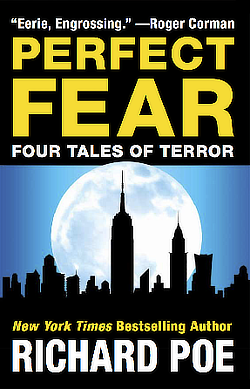Seven Steps to Writing Great Fiction
|
by Richard Poe Saturday, August 4, 2012 8:41 am Eastern Time |
Archives 1 Comment |

A FRIEND recently asked my advice about writing short stories, so I jotted down a few pointers for him, based upon my experience writing Perfect Fear: Four Tales of Terror. After sending off the e-mail, I realized that others might benefit from these observations as well. So here they are, Seven Steps to Writing Great Fiction.
STEP 1. READ THE SIGNS
You must learn to listen to “the voice that is great” within you.1 This is the voice of inspiration, the voice of your own genius, which speaks to you from the unconscious.2 It speaks through signs and symbols, specifically, through dreams, visions, emotions, hunches and coincidences.3 You must train yourself to pay close and constant attention to these signs, and to interpret them correctly. You must become a close observer of the workings of your own mind.4
STEP 2. FOLLOW THE TRAIL OF DESTINY
Every human being has a destiny, that is, a particular thing that you were always meant to do, or a particular path that you were always meant to walk.5 Reading the signs will lead you to your destiny. For a writer, reading the signs will reveal your proper subject matter. The signs will show you what topics are appropriate for you. They will show you how to write your masterpiece.
STEP 3. CONCEIVE THE STORY
The concept of your story — the basic plot and characters — will emerge from your unconscious mind, either through a dream or through a sudden flash of insight which strikes you in an odd moment. When it strikes, write it down. As you begin to pay close attention to the workings of your mind, you will find that story ideas begin bubbling forth, more ideas than you can possibly use. Write them all down, noting the exact dates when they occurred to you, and the exact time of day, if possible. The date and time are important, because these will help you to spot coincidences between your thought process and events in the larger world. As your list of story ideas grows, it will quickly become obvious to you which story you should write first. There will be one story on your list that excites you more than the others. Start with that one.
STEP 4: ENTER THE WRITING TRANCE
To write effectively, you must achieve a trance-like state, in which your entire being is focused on the work, mentally, physically and spiritually.6 This is accomplished through total immersion in your subject matter, to the exclusion of all other things. If you are writing a Western, for example, then your subject matter is the Wild West. You must immerse yourself in all things Western. Read Western novels, watch Western movies and think Western thoughts, morning, noon and night.
STEP 5: CHOOSE A ROLE MODEL
You must have a role model, some person to whom you look for inspiration and whom you seek to emulate. It doesn’t matter whether your role model is a writer or filmmaker, since writing and film are just two different ways of telling a story. You can learn from either medium. What is important about your role model is that it be someone whom you genuinely admire. It must be someone who is doing the same kind of work that you aspire to do. Choose the best of the best. Don’t pick some obscure person whom no one has ever heard of. Pick someone who is widely known and recognized as a leader in his field. If you want to write horror, choose someone on the level of a Stephen King. If you want to write spy novels, choose someone on the level of a John le Carré or a Robert Ludlum. When you have chosen your role model, read everything he has written (or watch every film he has made), and learn everything you can about that person’s life. Model yourself after him. Learn from him. Study his work closely, to see how he achieves his effects. This intensive study will not only broaden your knowledge of technique, but will also deepen your immersion in the writing trance.
STEP 6: ENTERTAIN YOURSELF
Write what you would consider the perfect entertainment, that is, write exactly the sort of story that you yourself would want to read. Create the perfect entertainment for a person just like yourself, a person with exactly your interests and exactly your tastes.
STEP 7: REVISE, REVISE, REVISE
There is no such thing as too much revision. Read the story over and over and over again. When you get tired of reading the story, and you no longer trust your objectivity, put the story aside for awhile. Do something else. Write another story. Then come back to the first story later, when your mind is fresh, and start reading and revising it again. Each time you read it, you will notice new problems. A problem is anything that causes you to feel confused, hesitant, bored or dissatisfied. You should never feel any of these things while reading a story. If you do, that means your story has a problem. And every problem must be fixed. Every rough spot must be smoothed. There are no shortcuts. When you revise, focus on speed, clarity, vividness and beauty. Speed is the pace at which the story moves. Clarity is the elimination of all sources of confusion. Vividness involves choosing those things that need to be described, and describing them as powerfully as possible.7 Beauty is the pleasing interplay between form and function. It means striking the right balance between the use of lovely words and images, and the telling of a gripping story. Too much loveliness, and the story drags. Too much action, without loveliness, and the reader feels dissatisfied.
If you apply these principles with rigor and persistence, you will achieve your fullest potential as a fiction writer, which is to say, the highest level that your talent permits. Remember that there are two aspects to achieving your highest potential as a writer. The first involves mental conditioning. The second involves technique. Both aspects are covered in these seven steps.
NOTES
[1] “The voice that is great within us” refers to the source of our inspiration, which speaks to us from the unconscious. The term was popularized by the late Hayden Carruth, who was once my poetry teacher at Syracuse University. Hayden used this expression as the title of an influential anthology of American poetry which he edited in 1970. He borrowed the expression from Wallace Stevens, who used it in his 1934 poem “Evening without Angels.” “Bare night is best…,” wrote Stevens. “Where the voice that is in us makes a true response. Where the voice that is great within us rises up, As we gaze at the rounded moon.”
[2] Here I use the word “genius” in its original sense. The ancient Romans believed that every person had a guardian spirit, called a genius, which guided that person toward his destiny. The ancient Greeks used the word daemon or daimon in a similar way. In the Greco-Roman world, when a person accomplished great deeds, his genius or daemon got credit for those achievements, not the person himself. Elizabeth Gilbert, the bestselling author of Eat, Pray, Love, famously called for a return to the ancient belief in the “genius” or “daemon” as a disembodied spirit which speaks to us from beyond. In Gilbert’s view, we should not refer to creative people as “geniuses,” but rather should think of artists and writers as people who have geniuses, that is, as people who communicate with disembodied spirits which guide them and tell them what to do. Gilbert proposed this rethinking of the creative process in a “TED Talk,” a speech at the TED 2009 conference. Transcript here. [footnote added 8/16/12]
[3] Dreams and visions have guided many authors to write their masterworks. Mary Wollstonecraft Shelley provides a famous example. In her Introduction to the 1831 edition of Frankenstein, Shelley describes the late-night outpouring of mental images which inspired her to write the novel. She relates, “When I placed my head on my pillow, I did not sleep, nor could I be said to think. My imagination, unbidden, possessed and guided me, gifting the successive images that arose in my mind with a vividness far beyond the usual bounds of reverie. … I saw the hideous phantasm of a man stretched out, and then, on the working of some powerful engine, show signs of life, and stir with an uneasy, half vital motion.” Similarly, Stephen King tells of a nightmare he suffered at the age of eight, in which he saw himself hanging from a noose — an image which King later used to chilling effect in his novel ‘Salem’s Lot. Finally, when I speak of “coincidence,” I am, of course, referring to the phenomenon that Carl Jung dubbed synchronicity.[footnote added 8/16/12]
[4] In order to hear “the voice that is great within us,” we must train ourselves to listen. We must become close observers of our own minds and souls, attuned to the slightest variations in our emotions and thought patterns. St. Ignatius Loyola (né Iñigo Loiolakoa) was one of history’s most acute self-observers. His system of self-analysis, codified in his book Spiritual Exercises, grew out of a six-year regimen of intense spiritual self-examination. In 1521, Loyola was crippled by a cannonball and forced to give up his former life as a soldier and lady’s man. He withdrew into his own inner world. From 1522-1528, Loyola studied the workings of his own mind. As one writer put it, the saint applied his “peculiar ability to monitor minutely and exactly the various moods and motions” that struck him during the course of any given day. “Out of this minute and unsparing self-observation,” the same writer observed, “Iñigo fashioned a set of rules by which one could discern what action was taking place in one’s spirit, and test who was the agent-spirit acting on one’s soul.” Thus did Loyola develop his 22 rules for discernment of spirits, by which the devotee might determine whether his thoughts or desires arose from good or evil impulses, and treat them accordingly. See Malachi Martin, The Jesuits (NY: Touchstone Books, 1987), p. 155. [footnote added 8/16/12]
[5] The concept of fate or destiny seems to exist in virtually every religion and culture. The ancient Greeks and Romans imagined that three fearsome goddesses controlled the destinies of gods and humans alike. The Greeks called these goddesses Moirai. The Romans called them Parcae. The idea of destiny persisted into Christian times. Indeed, it may be said that ancient beliefs about fate, in some ways, foreshadowed or prefigured later Christian teachings, in particular, the Christian doctrine of predestination, according to which our ultimate destinies have been determined since the beginning of time. References to predestination can be found in many passages of the Bible, such as Jeremiah 1:5, Psalm 139:16 and Romans 8:29. St. Augustine strongly espoused predestination, which he designated by the Latin word praedestinatio. Somewhat paradoxically, Christian teaching also holds that humans have free will, and that each of us may choose good or evil. Philosophers and theologians have sought, for many centuries, to reconcile the two concepts, but ultimately the relationship between free will and predestination remains an impenetrable mystery. [footnote added 8/18/12]
[6] “I think that writing is self-hypnosis, and you fall into a kind of trance,” Stephen King told CNN (10/05/2010). For King, the trick to maintaining a writing trance is to keep a strict work schedule and follow the same rituals and routines every day. In another interview, published in the book Writers Dreaming by Naomi Epel, King likened the creative mindset to a dream state. He remarked, “Part of my function as a writer is to dream awake. … Creative imaging and dreaming are just so similar that they’ve got to be related.” [footnote added 8/18/12]
[7] Description tends to be boring. Use as little of it as possible. Describe only those things which absolutely must be described, and keep your descriptions short. W. Somerset Maugham once wrote: “One of the difficulties that confronts the novelist is how to describe the appearance of his characters. The most natural way is of course the formal catalogue, the height, the complexion, the shape of the face, the size of the nose, and the color of the eyes. … I think we seldom form any exact image in our minds as a result of all these words. … The catalogue of characteristics is certainly dull…” See W. Somerset Maugham, A Writer’s Notebook, Preprinted from Cosmopolitan Magazine (New York, Cosmopolitan Magazine, 1949), pp 85-86 [footnote added 8/31/21]








Rule number 8: Live in an exciting place full of inspiration like NYC. Even our cab drivers and homeless people are great archetypes.
Sadly, in this economy, with store after store boarded up, it is as if we have lost bits of our community. The family-owned business seems to be a thing of the past. I miss the families that were a part of our lives.